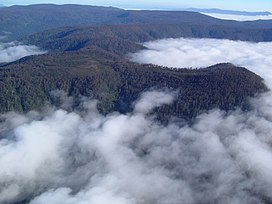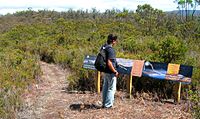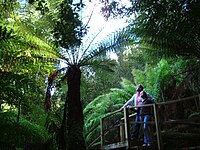| This article needs additional citations for verification. Please help improve this article by adding citations to reliable sources. Unsourced material may be challenged and removed. Find sources: "Mount Misery" Tasmania – news · newspapers · books · scholar · JSTOR (April 2017) (Learn how and when to remove this message) |
| Mount Misery | |
|---|---|
 | |
| Highest point | |
| Elevation | 690 m (2,260 ft) |
| Geography | |
| Location | Tasmania, Australia |
Mount Misery is the dominant feature overlooking Huonville in southern Tasmania. With an elevation of 690 metres (2,260 ft), it is typical of most of the peaks surrounding Huonville; but its location on a bend of the Huon River makes it the dominant feature in many tourist photos.
Geography
The mountain divides the localities of Lucaston to the north east, Ranelagh to the south and Judbury to the west. The Russell Ridge Conservation Area to the north links Mount Misery Habitat Reserve to Mount Wellington Park. The mountain is entirely within the Huon Valley watershed.
Administration
Local government
Mt Misery is within the Huon Valley Local Government Area.
Informal community habitat reserve
Many of the land owners on the slopes of Mount Misery and surrounding areas share common nature conservation values. As of 2017 these people own 68 individual titles and loosely apply the name "Mount Misery Habitat Reserve" to the protected area. About half of the titles are formally protected by conservation covenants that protect the natural values in perpetuity. These covenants include the first two conservation covenants issued in Tasmania. These covenants are created under the Private Forest Reserves Program operated by the Tasmanian government. Conservation covenants establish an agreement that sees important conservation values protected for biodiversity in perpetuity.
Land usage
Most of the land is used for nature-focused residences. Some is used solely for conservation, a few are used as weekend getaways and one group of five titles is an ecotourism resort.
Vegetation
The southern slopes are predominantly tall wet eucalyptus forest with small pockets of rainforest, growing in shallow peaty soils. The northern slopes are dry Eucalyptus tenuiramis on shallow mudstone soils. Most of the land is open grassland.
In general, the canopy is 20–30 metres (66–98 ft) high. Some trees are 50–70 metres (160–230 ft) meters tall.
Access

Public access is via a 5-kilometre (3.1 mi) walking track through rainforest and subalpine heathland to the boulders at the summit. Thirty interpretive panels explain the area's Aboriginal history and environmental issues. It takes approximately three hours to walk to the summit. There is no access charge.
The car park and track head are at Huon Bush Retreats, Browns Road, Ranelagh.
Gallery
-
 Aboriginal interpretive information on Mount Misery
Aboriginal interpretive information on Mount Misery
-
 Tree fern bridge, Huon Bush Retreats
Tree fern bridge, Huon Bush Retreats
-
 Tree Huggers at Huon Bush Retreats
Tree Huggers at Huon Bush Retreats
References
- "Local Government". Huon Valley Council Website.
- ^ Alomes, Jon. "Mount Misery Walk and Nature Reserve". Discover Tasmania. Retrieved 2017-07-01.
42°58′26″S 147°00′23″E / 42.9739°S 147.0064°E / -42.9739; 147.0064
Category: